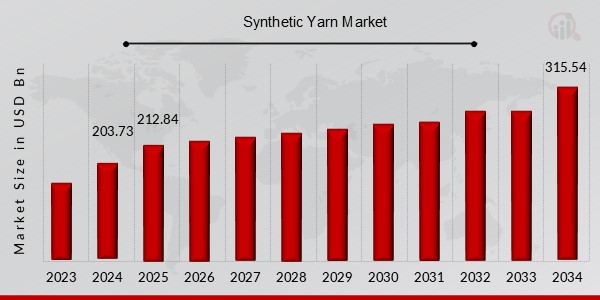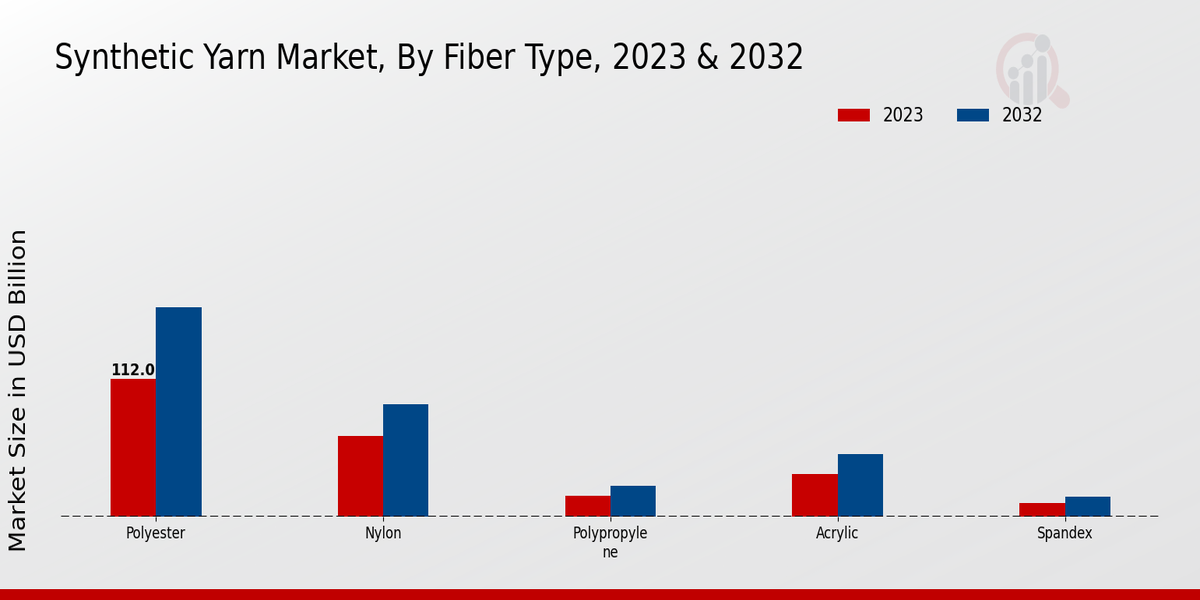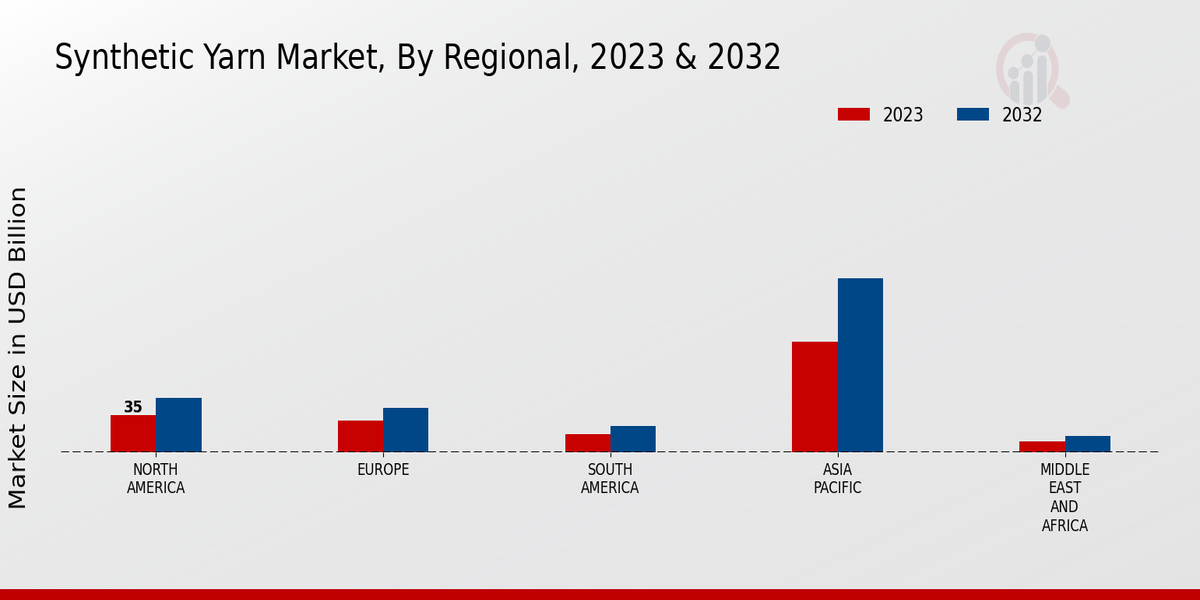Global Synthetic Yarn Market Overview
The Synthetic Yarn Market Size was estimated at 203.73 (USD Billion) in 2024. The Synthetic Yarn Industry is expected to grow from 212.84 (USD Billion) in 2025 to 315.54 (USD Billion) by 2034. The Synthetic Yarn Market CAGR (growth rate) is expected to be around 4.5% during the forecast period (2025 - 2034).
Key Synthetic Yarn Market Trends Highlighted
The Synthetic Yarn Market exhibits a growing demand driven by factors such as rising urbanization, increasing disposable income, and the expanding industry. This growth is particularly evident in emerging economies where there is a surge in demand for affordable and durable textiles.Recent trends in the Synthetic Yarn Market include the adoption of sustainable practices, such as the use of recycled materials and biodegradable fibers. This trend is driven by rising environmental awareness and increasing consumer demand for eco-friendly products. Additionally, there is a growing focus on innovation and product development, with manufacturers investing in research to develop new and improved synthetic yarns with enhanced properties such as strength, durability, and comfort.Key market opportunities lie in the expansion of the technical textiles segment, which offers promising growth potential in sectors such as automotive, medical, and construction. The market also presents opportunities for manufacturers that can cater to the growing demand for customized and niche synthetic yarns tailored to specific end-use applications.
 Source: Primary Research, Secondary Research, MRFR Database and Analyst Review
Synthetic Yarn Market Drivers
Source: Primary Research, Secondary Research, MRFR Database and Analyst Review
Synthetic Yarn Market Drivers
Increasing Demand from Textile Industry
The synthetic yarn market is primarily driven by the increasing demand from the textile industry. Synthetic yarns are widely used in the production of various textiles, including clothing, home furnishings, and industrial fabrics. The growing population and rising disposable incomes in developing countries are fueling the demand for textiles, which in turn is driving the demand for synthetic yarns. Synthetic yarns offer several advantages over natural fibers, such as durability, wrinkle resistance, and moisture wicking properties.These advantages make synthetic yarns ideal for a wide range of textile applications. The increasing demand for functional and performance-based textiles is also contributing to the growth of the synthetic yarn market. For instance, synthetic yarns are used in the production of sportswear, activewear, and protective clothing due to their moisture-wicking and antimicrobial properties.
Technological Advancements and Innovations
Technological advancements and innovations are another key driver of growth in the synthetic yarn market. The development of new and improved synthetic fibers and yarns is constantly expanding the range of applications for synthetic yarns. For example, the development of high-performance synthetic fibers, such as carbon fiber and aramid fiber, has opened up new possibilities in the aerospace, automotive, and construction industries. These high-performance synthetic fibers offer exceptional strength, lightweight, and durability, making them ideal for use in demanding applications.Additionally, advancements in spinning and processing technologies are improving the quality and efficiency of synthetic yarn production, which is further driving the growth of the market.
Growing Awareness of Sustainability
The growing awareness of sustainability is also driving the demand for synthetic yarns. Synthetic yarns offer several sustainability advantages over natural fibers. For example, synthetic yarns can be produced from recycled materials, reducing the environmental impact of textile production. Additionally, synthetic yarns are more durable and longer lasting than natural fibers, which reduces the need for frequent replacement and disposal. The increasing demand for sustainable and eco-friendly products is creating opportunities for the growth of the Synthetic Yarn Market Industry.
Synthetic Yarn Market Segment Insights:
Synthetic Yarn Market Fiber Type Insights
The Synthetic Yarn Market is segmented based on fiber type into polyester, nylon, polypropylene, acrylic, and spandex. Among these, polyester held the largest market share in 2023, accounting for over 60% of the global revenue. The dominance of polyester can be attributed to its versatility, durability, and cost-effectiveness. It is widely used in the production of clothing, home textiles, and industrial fabrics. Nylon, the second-largest segment, is known for its strength, elasticity, and resistance to abrasion. It is commonly used in the manufacturing of sportswear, swimwear, and carpets.Polypropylene, on the other hand, is a lightweight and water-resistant fiber that finds applications in packaging, ropes, and automotive interiors. Acrylic, a synthetic fiber resembling wool, offers warmth, softness, and flame resistance. It is primarily used in the production of sweaters, blankets, and upholstery. Spandex, also known as elastane or Lycra, is a highly elastic fiber that is often blended with other fibers to impart stretch and flexibility to garments. The growth of the synthetic yarn market is driven by rising demand from various end-use industries, including textiles, apparel, and automotive.The increasing adoption of synthetic fibers in technical applications, such as filtration and reinforcement, is also contributing to market expansion. Furthermore, advancements in fiber technology and the development of eco-friendly synthetic yarns are expected to drive future market growth.
 Source: Primary Research, Secondary Research, MRFR Database and Analyst Review
Synthetic Yarn Market End-Use Application Insights
Source: Primary Research, Secondary Research, MRFR Database and Analyst Review
Synthetic Yarn Market End-Use Application Insights
The Synthetic Yarn Market is segmented into apparel, home textiles, automotive, medical, and industrial applications. Apparel is the largest segment, accounting for over 50% of the Synthetic Yarn Market revenue in 2023. The growth of the apparel segment is driven by the increasing demand for synthetic fibers in clothing and sportswear due to their properties such as durability, wrinkle resistance, and moisture wicking. Home textiles is the second largest segment, accounting for over 25% of the Synthetic Yarn Market revenue in 2023.The growth of the home textiles segment is driven by the increasing demand for synthetic fibers in carpets, curtains, and other home furnishing products due to their properties such as stain resistance and easy care. Automotive is the third largest segment, accounting for over 10% of the Synthetic Yarn Market revenue in 2023. The growth of the automotive segment is driven by the increasing demand for synthetic fibers in automotive interiors and exterior components due to their properties such as lightweight and durability. Medical is the fourth largest segment, accounting for over 5% of the Synthetic Yarn Market revenue in 2023.The growth of the medical segment is driven by the increasing demand for synthetic fibers in medical devices and implants due to their properties such as biocompatibility and sterility. Industrial is the fifth largest segment, accounting for over 5% of the Synthetic Yarn Market revenue in 2023. The growth of the industrial segment is driven by the increasing demand for synthetic fibers in industrial applications such as ropes, belts, and filters due to their properties such as strength and durability.
Synthetic Yarn Market Yarn Count Insights
The Synthetic Yarn Market is segmented into fine count, medium count, and coarse count based on yarn count. Fine count yarn is expected to witness significant growth over the forecast period owing to its increasing demand in the production of high-quality fabrics for apparel, home textiles, and technical applications. The demand for fine count yarn is primarily driven by the growing disposable income and changing fashion trends, leading to a surge in demand for premium and luxury fabrics. Medium count yarn is also expected to grow steadily, primarily driven by its wide usage in the manufacturing of mid-range apparel, upholstery fabrics, and industrial textiles.Coarse count yarn, on the other hand, is anticipated to have a stable growth rate during the forecast period due to its limited applications primarily in the production of carpets, ropes, and packaging materials.
Synthetic Yarn Market Yarn Structure Insights
The Synthetic Yarn Market is segmented into Spun Yarn and Filament Yarn based on Yarn Structure. The Spun Yarn segment held a larger market share in 2023 and is projected to maintain its dominance during the forecast period. Growing demand for spun yarn in the textile industry, particularly for the production of fabrics like cotton, wool, and linen, is driving the segment's growth. The Synthetic Yarn Market for Spun Yarn is expected to reach a valuation of USD 112.4 billion by 2032, exhibiting a CAGR of 4.2%. The Filament Yarn segment is estimated to grow at a CAGR of 4.6% from 2024 to 2032.The increasing use of filament yarn in various applications, including sportswear, home textiles, and industrial fabrics, is contributing to the segment's growth. The Synthetic Yarn Market for Filament Yarn is projected to reach a valuation of USD 164.1 billion by 2032.
Synthetic Yarn Market Dyeing Process Insights
The dyeing process segment is a significant part of the Synthetic Yarn Market, contributing to its overall growth. Yarn dyeing, which involves coloring the yarn before it is woven or knitted, accounted for the larger share of the dyeing process segment in 2023. The increasing demand for customized and vibrant colors in textiles, particularly in the fashion and home furnishing industries, has driven the growth of yarn dyeing. Piece dyeing, which involves coloring the fabric after it has been woven or knitted, also holds a notable share of the dyeing process segment.The growing adoption of piece dyeing techniques in industries such as automotive and technical textiles, where specific color requirements and performance characteristics are crucial, has contributed to its market growth. The Synthetic Yarn Market is expected to continue expanding, with both yarn dyeing and piece dyeing processes playing significant roles in meeting the evolving demands of various industries.
Synthetic Yarn Market Regional Insights
The regional segmentation of the Synthetic Yarn Market offers insights into the market's geographical distribution and growth potential. In 2023, North America held the largest market share, accounting for approximately 35% of the global revenue. Europe followed closely with a share of around 30%, driven by strong demand from major textile and apparel industries. The Asia-Pacific region is projected to witness significant growth over the forecast period, owing to the rising demand for synthetic yarns in emerging economies like China and India.South America and the Middle East Africa regions are expected to contribute a smaller but growing share to the global market.
 Source: Primary Research, Secondary Research, MRFR Database and Analyst Review
Synthetic Yarn Market Key Players And Competitive Insights:
Source: Primary Research, Secondary Research, MRFR Database and Analyst Review
Synthetic Yarn Market Key Players And Competitive Insights:
Major players in Synthetic Yarn Market are constantly innovating and developing new products to meet the evolving needs of their customers. They are also actively involved in mergers and acquisitions to expand their product portfolio and geographical reach. Leading Synthetic Yarn Market players are investing heavily in research and development to develop new and improved products. They are also focusing on developing sustainable and environmentally friendly products. The Synthetic Yarn Market industry is characterized by intense competition, with a large number of players competing for market share. The competitive landscape is expected to remain fragmented in the coming years, with no single player holding a dominant position.INVISTA is a leading company in the Synthetic Yarn Market industry. The company offers a wide range of synthetic yarns, including nylon, polyester, and spandex. INVISTA's products are used in a variety of applications, including apparel, home furnishings, and automotive. The company has a strong global presence, with operations in over 20 countries. INVISTA is committed to innovation and sustainability and is constantly developing new and improved products. The company is also focused on reducing its environmental impact and has set a goal of becoming carbon neutral by 2050.Toray Industries is a major competitor in the Synthetic Yarn Market industry. The company offers a wide range of synthetic yarns, including nylon, polyester, and acrylic. Toray's products are used in a variety of applications, including apparel, home furnishings, and industrial products. The company has a strong global presence, with operations in over 20 countries. Toray is committed to innovation and sustainability and is constantly developing new and improved products. The company is also focused on reducing its environmental impact and has set a goal of becoming carbon neutral by 2050.
Key Companies in the Synthetic Yarn Market Include:
- Asahi Kasei Corporation
- Braskem
- Sabic
- LyondellBasell Industries Holdings
- Indorama Ventures
- Reliance Industries
- Formosa Plastics Corporation
- Evonik Industries
- Teijin Limited
- Covestro
- Exxon Mobil
- Dow Chemical Company
- China Petrochemical Corporation
- Toray Industries
- PTT Global Chemical
Synthetic Yarn Market Industry Developments
Rising demand from end-use industries such as textiles, automotive, and construction is driving market growth. Technological advancements, including the development of new fibers and sustainable production processes, are further propelling market expansion. Recent developments include the launch of bio-based synthetic yarns, collaborations between yarn manufacturers and fashion brands, and increased adoption of synthetic yarns in sportswear and activewear. Stringent environmental regulations and fluctuating raw material prices pose challenges to market growth. Key players in the market include Indorama Ventures, Reliance Industries, and Toray Industries.
Synthetic Yarn Market Segmentation Insights
-
Synthetic Yarn Market Fiber Type Outlook
- Polyester
- Nylon
- Polypropylene
- Acrylic
- Spandex
-
Synthetic Yarn Market End-Use Application Outlook
- Apparel
- Home Textiles
- Automotive
- Medical
- Industrial
-
Synthetic Yarn Market Yarn Count Outlook
- Fine Count
- Medium Count
- Coarse Count
-
Synthetic Yarn Market Yarn Structure Outlook
-
Synthetic Yarn Market Dyeing Process Outlook
-
Synthetic Yarn Market Regional Outlook
-
North America
-
Europe
-
South America
-
Asia Pacific
-
Middle East and Africa
| Report Attribute/Metric |
Details |
| Market Size 2024 |
203.73 (USD Billion) |
| Market Size 2025 |
212.84 (USD Billion) |
| Market Size 2034 |
315.54 (USD Billion) |
| Compound Annual Growth Rate (CAGR) |
4.5% (2025 - 2034) |
| Report Coverage |
Revenue Forecast, Competitive Landscape, Growth Factors, and Trends |
| Base Year |
2024 |
| Market Forecast Period |
2025 - 2034 |
| Historical Data |
2020 - 2024 |
| Market Forecast Units |
USD Billion |
| Key Companies Profiled |
Asahi Kasei Corporation, Braskem, Sabic, LyondellBasell Industries Holdings, Indorama Ventures, Reliance Industries, Formosa Plastics Corporation, Evonik Industries, Teijin Limited, Covestro, Exxon Mobil, Dow Chemical Company, China Petrochemical Corporation, Toray Industries, PTT Global Chemical |
| Segments Covered |
Fiber Type, End-Use Application, Yarn Count, Yarn Structure, Dyeing Process, Regional |
| Key Market Opportunities |
Rising demand for performance fabrics Growing popularity of sustainable materials Increasing adoption in technical applications Technological advancements in fiber production Expansion into emerging markets |
| Key Market Dynamics |
Rising demand from end use industries Advancements in technology Growing awareness of ecofriendly materials Increasing demand for lightweight and durable materials Expansion of ecommerce platforms |
| Countries Covered |
North America, Europe, APAC, South America, MEA |
Frequently Asked Questions (FAQ) :
The Synthetic Yarn Market is expected to reach 315.54 Billion USD by 2034, expanding at a CAGR of 4.5% from 2025 to 2034.
North America is the dominant region in the Synthetic Yarn Market, accounting for over 55% of the market share.
Rising demand from end-use industries such as automotive, construction, and textiles is a major growth driver for the Synthetic Yarn Market.
The automotive segment is projected to grow at the highest CAGR during the forecast period, driven by increasing vehicle production and demand for lightweight materials.
Major players include Indorama Ventures, Reliance Industries, Toray Industries, and Kolon Industries.
Growing consumer awareness and regulatory pressure are driving the adoption of sustainable synthetic yarns, creating opportunities for manufacturers focusing on eco-friendly production.
Advancements in fiber engineering and spinning technologies are enhancing the properties and functionality of synthetic yarns, expanding their application scope.
Fluctuating raw material prices and intense competition from natural fibers pose challenges to the growth of the Synthetic Yarn Market.
The Synthetic Yarn Market is projected to reach approximately 220 Billion USD by 2025.
The market is segmented based on fiber type (polyester, nylon, polypropylene, etc.), application (automotive, construction, textiles, etc.), and region (Asia-Pacific, Europe, North America, etc.).
















